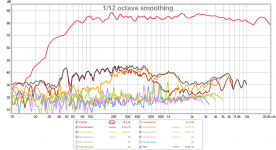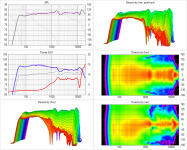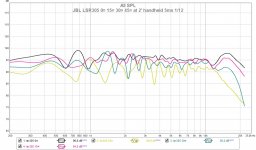Thank you for the report.My -25dB is "worst scenario", the cabinet's back wall was opened, cavity working as an amplifier in the measurement. But still, with music the fixed speaker sounds much better than original!
But I'm doubt that transverse bracing really helps. Because the driver not contacted with wooden part of cabinet and screwed to the plastic face plate only. I think the good idea of modding would be attaching the driver to wooden part of cabinet by any kind of glue may be... Or to glue a brace between plastic faceplate and cabinet?
If you apply JBL's sub LSR310s the sub will cut signal below 80hz from monitors (see manual). So no need to seal the ventAnyone sealed the vent (aperiodic, aka, a sock or 3, or completely closed off) and then run them with a sub? 6L6 is that what you're doing? Seems like they'd do a whole load better.
This file will make LSR305 transient perfect when playing from Foobar.I had to return them because could not sound anywhere near as good as my FAST with 10F/RS225. But what bothered me was that despite being internally DSP’d - the response was not flat.
Download "convolver" for Foobar and put this file "FIR.wav" to it.
After that 305's will play meander and will have ideal Step response when playing from Foobar.
Attachments
I did not have peaky distortion rattle on the LSR305’s I measured but a broad hump - looks like panel resonances which dominate though. The 3rd harmonic from 200hz to 600Hz is especially troubling.

It was a bit disappointing considering all the rave 5 star reviews I read prior to buying them. Also, the published response was flat - not waivering like this.
Anyhow, even at $210/pair I did not think they were worth it. The mid bass was lacking presence and sound was just not clean enough I ended up returning them. The value would have been incredible had they sounded good. But IMO, a well designed passive 2-way with a solid cabinet and decent but budget drivers sound better.
Certainly, the GR Research XL’s are superior in flatness of response and distortion. Just missing the waveguide.

It was a bit disappointing considering all the rave 5 star reviews I read prior to buying them. Also, the published response was flat - not waivering like this.
Anyhow, even at $210/pair I did not think they were worth it. The mid bass was lacking presence and sound was just not clean enough I ended up returning them. The value would have been incredible had they sounded good. But IMO, a well designed passive 2-way with a solid cabinet and decent but budget drivers sound better.
Certainly, the GR Research XL’s are superior in flatness of response and distortion. Just missing the waveguide.
Last edited:
Phase can be approximately derived from amplitude response + the known crossover frequency. If you EQ the amplitude response to flat, you end up with an all pass filter at the crossover frequency.
Yeah that might be it on this speaker, something 4th order i´ll bet.
Haven´t study much how the phase should look when mid/high timing changes on these xo´s, im more familiar with flatter phase speakers
Haven´t study much how the phase should look when mid/high timing changes on these xo´s, im more familiar with flatter phase speakers
Last edited:
xrk, obviously our speakers were faulty units, something loose inside? My measurements line up with noaudiophile well.
Dimitry, the amplifier board takes whole backwall, it is impossible to connect front and backplate together. Sidewalls cover wide area and are homogenous and flat, so the best possible benefit from bracing comes that way, and it is easy because backwall can be screwed off.
kimmosto,what do you think is causing that wiggle in directivity xo ? Xo is LR4 @1700Hz
Here some more of my reasurements before and after tweaking. All done quick and dirty in mancave, mic held by hand and angles estimated visually.
Dimitry, the amplifier board takes whole backwall, it is impossible to connect front and backplate together. Sidewalls cover wide area and are homogenous and flat, so the best possible benefit from bracing comes that way, and it is easy because backwall can be screwed off.
kimmosto,what do you think is causing that wiggle in directivity xo ? Xo is LR4 @1700Hz
Here some more of my reasurements before and after tweaking. All done quick and dirty in mancave, mic held by hand and angles estimated visually.
Attachments
kimmosto,what do you think is causing that wiggle in directivity xo ?
There's no wiggle in directivity - other than vertical lobing of two separate sources. Response shape around XO freq is global in horizontal plane. Note that directivity charts are not normalized.
Does anyone remember back to around 1990 and the flexible borosilicate stuff we used to pour into enclosures to damp them? It worked well, but doesn't appear to be available anymore. Perhaps it caused pre-cancerous lesions and neurological problems, although I blame those on other youthful transgressions. ;-)
Did anybody any amp modernization? Electrolytic capacitor upgrade or etc.? any idea - is it possible to correct DSP filter STA350bw and make transient perfect crossover?
I understood and appreciate your measurement.
I already opened them and saw the amp board.
by the way in MKII - JBL upgraded plastic faceplate.
Dimitry, the amplifier board takes whole backwall, it is impossible to connect front and backplate together. Sidewalls cover wide area and are homogenous and flat, so the best possible benefit from bracing comes that way, and it is easy because backwall can be screwed off.
I understood and appreciate your measurement.
I already opened them and saw the amp board.
by the way in MKII - JBL upgraded plastic faceplate.
Forgot to say that before and after tweak measurements are from different units.
Here distortion measurements of a fixed unit. For comparison a diy SEAS 18-Coaxial in a 24mm MDF closed cabinet of almost same size.
Also step response of LSR
Here distortion measurements of a fixed unit. For comparison a diy SEAS 18-Coaxial in a 24mm MDF closed cabinet of almost same size.
Also step response of LSR
Attachments
Last edited:
Noaudiophile did try to deaden the face of the 308, but it didn't seem to help that speaker
lsr 308 mods
if you want to make mod to electronics
inductor mod
lsr 308 mods
if you want to make mod to electronics
inductor mod
There's no wiggle in directivity - other than vertical lobing of two separate sources. Response shape around XO freq is global in horizontal plane. Note that directivity charts are not normalized.
What is causin this wiggle in horizontal DI?
Attachments
My directivity measurements show that the waveguide does an excellent job. The wiggle neat 1700Hz is the crossover point - I guess they don't have the time alignment dialed in well enough that there is cancellation in what I assume is an even order XO. It is all DSP so not sure what it really is without surgery thereby voiding ability to return.
Attachments
What is causin this wiggle in horizontal DI?
That is not "horizontal DI". It is directivity index which is calculated in both planes, and the wiggle is coming from vertical plane - as already told.
My directivity measurements show that the waveguide does an excellent job. The wiggle neat 1700Hz is the crossover point - I guess they don't have the time alignment dialed in well enough that there is cancellation in what I assume is an even order XO. It is all DSP so not sure what it really is without surgery thereby voiding ability to return.
Not sure there is much flexible DSP inside the 305.
For the full DSP experience JBL has the 705 but they also come in birch ply cabs, bigger amps, better drivers and cost $1k each.
- Home
- Loudspeakers
- Multi-Way
- JBL LSR305 tweaking















